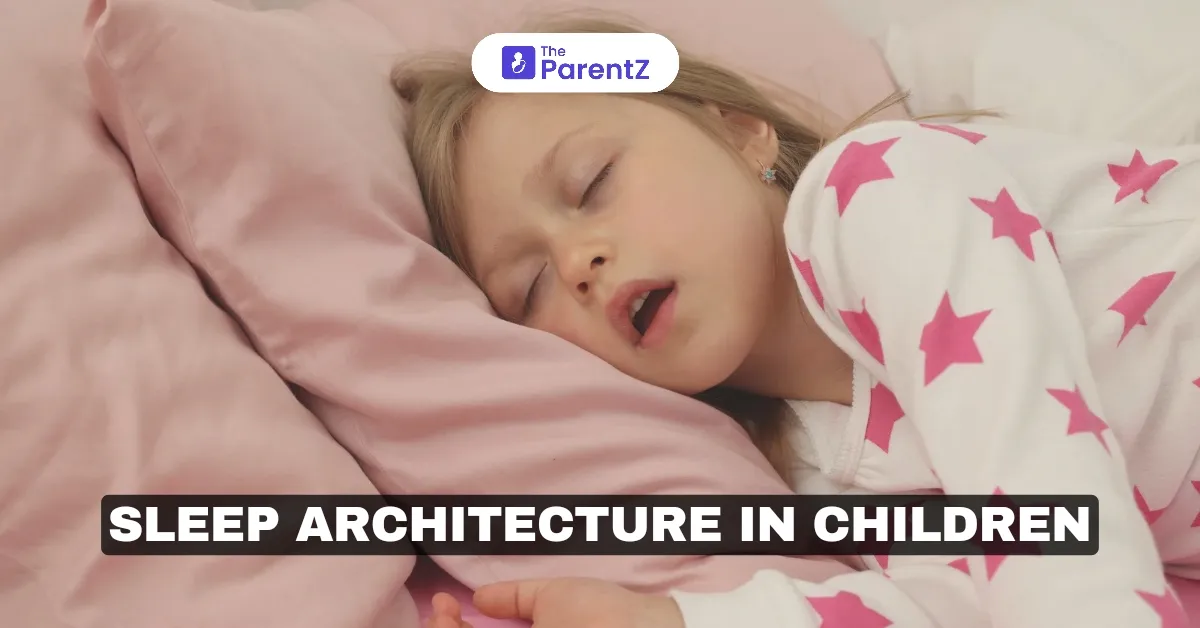Sleep architecture refers to the structure and pattern of sleep cycles and stages that make up a complete night’s sleep. In children, sleep architecture differs significantly from adults, adapting as they grow. This article explains the components of sleep architecture, why it matters for children’s health and development, and how it changes as children mature.
What is Sleep Architecture?
Sleep architecture is the term used to describe the organization of different sleep stages throughout the night. It includes both non-rapid eye movement (NREM) and rapid eye movement (REM) stages, which occur in cycles. A complete cycle lasts about 60 minutes in infants and gradually lengthens as children grow, reaching about 90 minutes by adolescence.
Key Components of Sleep Architecture
1. NREM Sleep (Non-Rapid Eye Movement)
• This includes three stages, each progressively deeper:
• NREM Stage 1: The lightest stage of sleep, a transition between wakefulness and sleep.
• NREM Stage 2: Light sleep, where heart rate and body temperature drop.
• NREM Stage 3: Deep sleep, also called slow-wave sleep (SWS), critical for physical restoration and growth.
2. REM Sleep (Rapid Eye Movement)
• REM sleep is characterized by rapid eye movements, increased brain activity, and dreaming. This stage plays a crucial role in memory consolidation and emotional regulation.
Importance of Sleep Architecture for Children
Sleep architecture in children supports critical developmental processes. Each stage serves a specific purpose in physical, cognitive, and emotional development:
1. Growth and Physical Development
• Deep sleep (NREM Stage 3) is when the body releases growth hormone, essential for physical growth and muscle repair in children. This stage also helps boost immune function.
2. Cognitive and Memory Development
• REM sleep aids in memory consolidation, learning, and the processing of emotions. Children, who are constantly acquiring new skills, greatly benefit from this stage.
3. Emotional and Behavioral Regulation
• Balanced sleep architecture supports emotional regulation. Disruptions in sleep can lead to mood disturbances, irritability, and behavioral issues.
How Sleep Architecture Changes with Age
Infants (0–12 Months)
• Sleep Duration: 12–16 hours per day, with multiple sleep periods.
• Sleep Cycles: Shorter cycles (about 50–60 minutes) with almost equal amounts of NREM and REM sleep.
• REM Dominance: Infants spend around 50% of their sleep in REM, supporting rapid brain development.
Toddlers (1–3 Years)
• Sleep Duration: 11–14 hours per day, often with a nap during the day.
• Changes in Cycles: Sleep cycles lengthen, and REM sleep decreases slightly. Deep NREM sleep (Stage 3) becomes more prominent, supporting physical growth and immune health.
Preschoolers (3–5 Years)
• Sleep Duration: 10–13 hours per day, typically with one afternoon nap.
• NREM Growth: Deep sleep continues to increase, while REM sleep stabilizes at around 25% of total sleep.
School-Age Children (6–12 Years)
• Sleep Duration: 9–12 hours per night, with a reduction in daytime napping.
• Sleep Architecture Stabilizes: NREM Stage 3 (deep sleep) remains high, supporting ongoing physical growth and cognitive functions, such as problem-solving.
Adolescents (13–18 Years)
• Sleep Duration: 8–10 hours per night, though many adolescents experience a natural delay in sleep onset.
• Shift in Sleep Cycles: The proportion of REM sleep and total deep NREM sleep begins to resemble adult sleep patterns. However, changes in circadian rhythms can lead to delayed sleep onset and sleep deprivation.
Factors Influencing Sleep Architecture in Children
1. Sleep Environment
• A quiet, dark, and comfortable sleep environment supports balanced sleep architecture, promoting deep and restorative sleep.
2. Regular Sleep Schedule
• Consistent bedtimes and wake times reinforce healthy sleep cycles, ensuring that children experience all stages of sleep in appropriate amounts.
3. Physical Activity
• Physical activity during the day can enhance sleep quality, increasing time spent in deep NREM sleep.
4. Screen Time
• Exposure to screens before bedtime can disrupt sleep architecture by delaying sleep onset and reducing REM sleep, as blue light from screens affects melatonin production.
5. Diet and Nutrition
• A balanced diet supports healthy sleep, as nutritional deficiencies can negatively impact sleep stages, particularly REM sleep.
When to Be Concerned About Sleep Architecture in Children
Although variations in sleep architecture are normal, certain signs may indicate an issue with a child’s sleep structure:
• Frequent Awakenings: If a child wakes up frequently, it may suggest disrupted sleep architecture, affecting deep sleep and REM stages.
• Persistent Daytime Sleepiness: Excessive daytime sleepiness can be a sign that sleep architecture is being interrupted, affecting overall sleep quality.
• Behavioral or Learning Difficulties: If a child has mood or cognitive difficulties, disrupted sleep architecture could be a contributing factor.
• Symptoms of Sleep Disorders: Issues like sleep apnea, night terrors, or sleepwalking can interfere with sleep architecture and should be evaluated by a healthcare provider if persistent.
Final Thoughts on Sleep Architecture in Children
Sleep architecture plays a foundational role in a child’s growth, cognitive development, and emotional health. By understanding and supporting healthy sleep patterns, parents can help their children achieve the rest needed for optimal development. Establishing consistent routines, creating a sleep-friendly environment, and addressing any sleep disturbances can ensure balanced sleep architecture, promoting healthy sleep for years to come.








Be the first one to comment on this story.